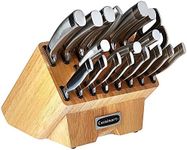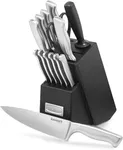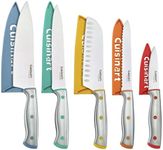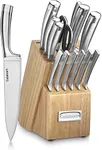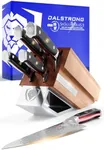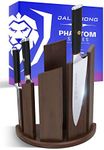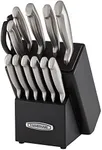Buying Guide for the Best Cuisinart Knives
Choosing the right Cuisinart knife can significantly enhance your cooking experience. The right knife will make food preparation easier, safer, and more enjoyable. When selecting a knife, consider the type of food you frequently prepare, your comfort level with different knife sizes and weights, and the maintenance required to keep the knife in good condition. Here are some key specifications to consider when choosing a Cuisinart knife.Blade MaterialThe blade material is crucial as it affects the knife's sharpness, durability, and ease of maintenance. Common materials include stainless steel, high-carbon stainless steel, and ceramic. Stainless steel is resistant to rust and easy to maintain, making it a good all-around choice. High-carbon stainless steel is harder and holds an edge longer but requires more care to prevent rust. Ceramic blades are extremely sharp and lightweight but can be brittle and prone to chipping. Choose a material based on your willingness to maintain the knife and the type of cutting tasks you perform.
Blade TypeBlade type refers to the shape and edge of the knife. Common types include straight edge, serrated, and granton edge. A straight edge is versatile and suitable for precise cuts, making it ideal for slicing vegetables and meats. Serrated edges are great for cutting through tough or crusty surfaces like bread. Granton edges have small indentations that prevent food from sticking to the blade, making them perfect for slicing meats. Consider what you will be cutting most often to determine the best blade type for your needs.
Handle MaterialThe handle material affects the knife's comfort, grip, and durability. Common materials include plastic, wood, and stainless steel. Plastic handles are lightweight and easy to clean but may not be as durable. Wood handles offer a traditional look and comfortable grip but require more maintenance to prevent damage from moisture. Stainless steel handles are durable and easy to clean but can be slippery when wet. Choose a handle material that feels comfortable in your hand and suits your maintenance preferences.
Knife BalanceKnife balance refers to the distribution of weight between the blade and the handle. A well-balanced knife feels comfortable and stable in your hand, making it easier to control. To test the balance, hold the knife at the point where the blade meets the handle. If it feels evenly weighted, it is well-balanced. A knife that is too blade-heavy or handle-heavy can cause fatigue and reduce precision. Choose a knife that feels balanced and comfortable for your hand size and strength.
Blade LengthBlade length affects the knife's versatility and ease of use. Common lengths range from 3 inches (paring knives) to 12 inches (chef's knives). Shorter blades (3-5 inches) are ideal for detailed tasks like peeling and trimming. Medium blades (6-8 inches) are versatile and suitable for most kitchen tasks, including chopping and slicing. Longer blades (9-12 inches) are great for cutting large items like melons or roasts but can be harder to control. Choose a blade length based on the types of food you prepare and your comfort level with different knife sizes.
MaintenanceMaintenance involves how easy it is to keep the knife sharp and clean. Some knives require regular honing and occasional sharpening to maintain their edge, while others may need less frequent care. Stainless steel and ceramic blades are generally easier to maintain than high-carbon steel, which can rust if not properly cared for. Consider how much time and effort you are willing to invest in maintaining your knife when making your choice.


